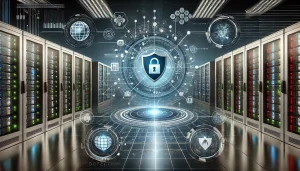Advanced Strategies in Enterprise Cybersecurity
 Scenario: Imagine a multi-national organization expanding its operations. Cybersecurity measures may not align with the organization’s goals without a proper blueprint, leading to vulnerabilities.
Scenario: Imagine a multi-national organization expanding its operations. Cybersecurity measures may not align with the organization’s goals without a proper blueprint, leading to vulnerabilities.
Enterprise Security Architecture is the bedrock of security for any expansive system. Its essence lies in providing a comprehensive approach to security measures’ design, implementation, and management. As businesses burgeon, a security architecture that integrates with the organization’s mission becomes paramount. ESA plays this integrative role, preventing potential security loopholes and ensuring a unified defense system against threats.
Central to the efficacy of ESA is its adaptability. With changing business dynamics, security measures must evolve concurrently. An optimized ESA smooths these transitions, shielding the organization from emerging threats. Moreover, the onus of a successful ESA is not solely on the IT department. Everyone has a part to play, from the boardroom to the server room. Collective involvement ensures that the architecture remains robust, resilient, and adaptive.
Recommendation: For cybersecurity professionals, the continual evaluation and improvement of the ESA is essential. Stay updated with the latest trends, threats, and solutions. Collaborate with stakeholders, refine the architecture, and ensure your organization’s security blueprint remains impervious.
(Visit Jason's Amazon Authors Page)
Security Information and Event Management (SIEM)
Scenario: A large retail company detects an unprecedented spike in server requests late at night. Without SIEM, determining the nature and threat of these requests would be like finding a needle in a haystack.
Security Information and Event Management stands as a cornerstone of Cybersecurity. It offers real-time analysis of security alerts by amalgamating data from myriad sources. This consolidated perspective is instrumental for organizations to maintain a bird’s-eye view of their security stance. SIEM processes logs from diverse devices ranging from network devices to specialized security systems through extensive data collection and aggregation mechanisms.
The dynamism of SIEM is showcased in its real-time analysis. Immediate detection of anomalies allows swift countermeasures, attenuating potential harm. Moreover, SIEM is not just a reactive tool; its proactive capabilities, such as filtering irrelevant data through correlation rules, ensure that security personnel can concentrate on genuine threats.
Recommendation: Cybersecurity experts should periodically refine the SIEM correlation rules to reflect the ever-evolving threat landscape. Regular audits, paired with updated threat intelligence, will ensure that SIEM remains an effective sentinel against cyber threats.
Managing Network Perimeters
Scenario: A financial institution migrates a significant portion of its operations to the cloud. Traditional boundary defenses are no longer sufficient. How does it ensure robust security in this new environment?
Network perimeters, in Cybersecurity, serve as the fortifications defending an organization’s data sanctity. The evolution of business structures, especially with the cloud adoption wave, necessitates an agile perimeter management strategy. As the vanguard of this defense, firewalls scrutinize traffic, allowing only legitimate communications.
However, as cyber strategies evolve, the zero-trust model takes precedence. Trust is no longer an inside job. Each request, irrespective of origin, undergoes thorough verification, bolstering the organization’s defense mechanisms. Layered defenses further accentuate this robustness, combining multiple tools and strategies to fend off cyber-attacks.
Recommendation: Professionals should adopt a multifaceted approach to perimeter security. Continuously update firewall rule sets, integrate advanced threat detection systems, and regularly educate internal teams about the importance and methods of maintaining perimeter security.
Data Loss Prevention (DLP)
Scenario: An employee of a healthcare provider inadvertently sends patient data to an external party. Without DLP, such leaks can go unnoticed until it is too late.
Data Loss Prevention emerges as an essential armament in the modern digital era. Its primary objective is monitoring the data lifecycle—whether in transit, at rest, or in use. Such meticulous monitoring ensures that malicious or inadvertent data leaks are promptly identified and thwarted. DLP systems can prevent unauthorized data movements by implementing strict controls, making them invaluable for organizations dealing with sensitive information.
DLP goes beyond just technological measures. A solid DLP strategy is rooted in clear organizational policies defining data categories, sensitivities, and handling procedures. Thus, while DLP tools act as the gatekeepers, the underlying policies dictate their effectiveness.
Recommendation: Cybersecurity professionals must ensure their DLP strategies are robust and flexible. Regularly review and update data categorization and handling policies and ensure that DLP measures facilitate business operations rather than hinder them.
User and Entity Behavior Analytics (UEBA)
Scenario: In a tech conglomerate, employees access databases they have never accessed. Traditional security measures might miss this, but UEBA flags it immediately.
UEBA is a testament to integrating machine learning and big data in Cybersecurity. UEBA systems establish a “normal” behavioral baseline by continuously monitoring user and system activities. Deviations from this norm can be indicative of potential security breaches. The adaptability of UEBA is its core strength. Unlike traditional systems that function based on static rules, UEBA continuously evolves, refining its understanding of user behaviors and adjusting its baselines.
By filtering through the vast volumes of data and focusing on high-risk activities, UEBA ensures that security teams are not inundated with false positives. Its holistic approach means that regardless of the type of threat—insider or outsider—UEBA provides crucial insights that enable prompt action.
Recommendation: Cybersecurity teams should integrate UEBA solutions into their security infrastructure. Regularly refine its parameters, collaborate with other security tools, and ensure its machine learning capabilities are harnessed to their fullest potential.
